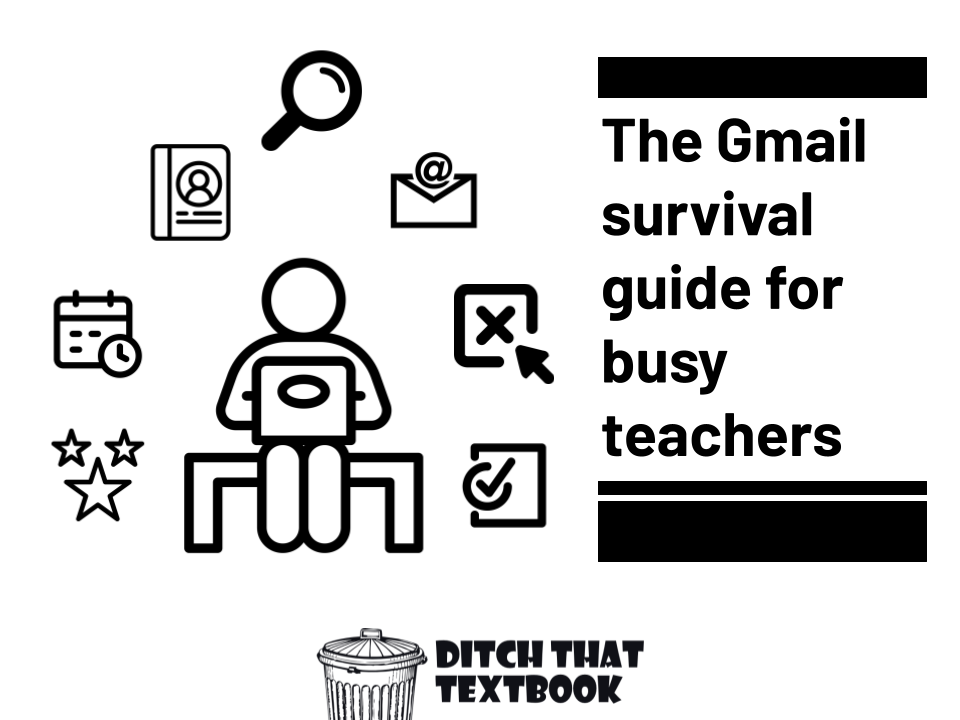
Email can consume our lives. With some strategies, though, we can minimize the impact it has. Here are some tips to help with email overwhelm.
Does it feel like email consumes your life — or too much of your time at school or at home?
I once heard someone describe email as “requests for your time for other people’s agendas and not your own.” There’s definitely some truth to this.
Seems like the textbook example of educators’ use of email is to check it often, respond whenever and spend lots of time doing repetitive email tasks.
If your inbox owns you, it drags you back in time after time without feeling like you’ve accomplished much of anything when you’re done.
But if you can tame your email and have it work for you, you have more time for the things that matter most — professionally and personally.
Here are 20 actions you can take to whip your Gmail life into shape:

1. Schedule emails to send at the end of the day
Ever get stuck in an email thread — kind of like a thread of messages on Twitter or a group text? You’re bouncing emails back and forth every few minutes because each of you sends replies immediately.
Pretty unproductive, huh? For me, I spend way more time than I need to in those email conversations.
If you schedule your email to go out at the end of the day instead, replies come in when you’re not at your desk. Answering emails at one (or a few) specific times instead of as they come in is something productivity experts suggest.
It's easy to schedule messages in Gmail. In a web browser, use the drop down triangle next to "Send" to choose "Schedule send" and choose a date and time. On the mobile app, use the three dots menu button next to the send button to choose "Schedule send."
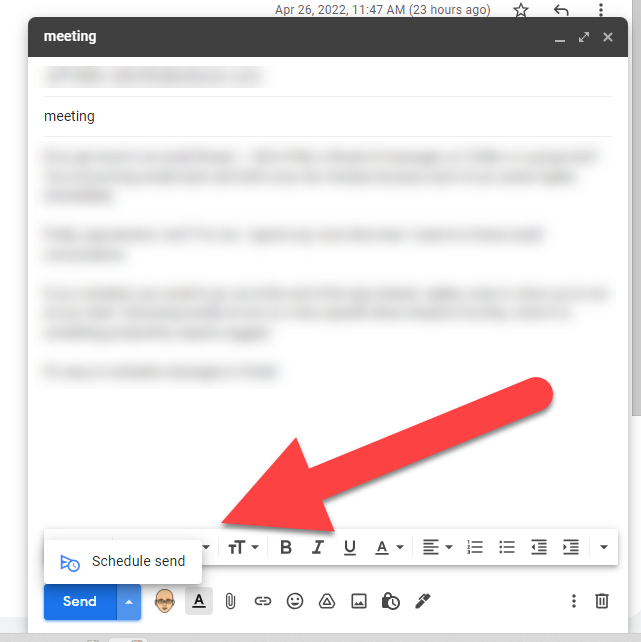

2. Suggest a course of action
Tell me if this sounds familiar:
“What time works best for you?” <send>
“I’m flexible. Suggest a time. I’m sure your schedule is busier.” <send>
“Next week works for me. Are there any conflict days for you?” <send>
“I’m booked on Tuesday, but the rest of the week is free. Thursday?” <send>
“Thursday’s no good. How about Friday? I have the whole morning free.” <send>
Back and forth, back and forth until FINALLY you both land on a time and date.
It doesn’t have to be this way, says Tim Ferriss in the book The Four-Hour Workweek. “Offer a solution. Stop the back-and-forth and make a decision. Practice this in both personal and professional environments.”
Start with a solution, and if the other party says no or suggests another time, that’s OK. We don’t have to get trapped in the “scheduling shuffle” if we start with a solution.

3. Pause your inbox
I get owned by my notifications sometimes — on my phone and when I have Gmail open on my computer. A new message comes in and I switch over to read it. Then I answer it. Then it takes me forever to get back on task with what I was working on before.
Boomerang (boomeranggmail.com) is a Gmail-focused Chrome extension that offers Inbox Pause. It stops messages from landing in your inbox (causing those distracting notifications) until you’re ready for them. Set pre-determined times for all of your email to be delivered.
It’s kind of like the mail carrier showing up at a specific time of day, but for your email.
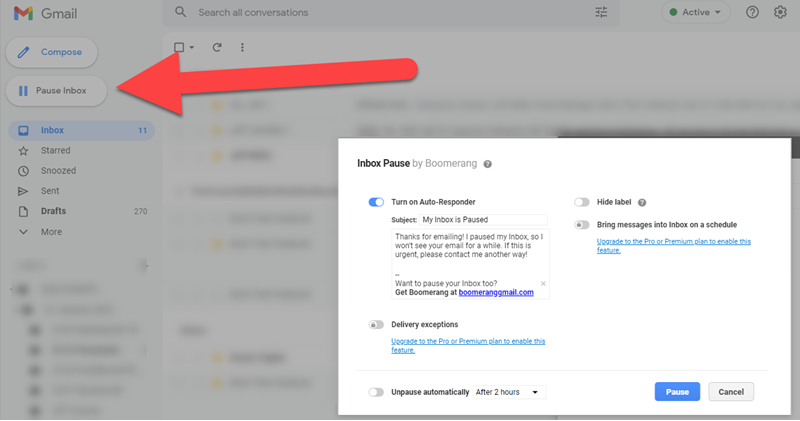

4. Use the unsubscribe button — a lot
A few weeks ago, I noticed that I was getting a ton of messages I didn’t really care about. They were from companies — Old Navy, Target, ed tech companies — who had collected my email address from a transaction or a sign-up. I kept getting their emails but wasn’t opening any of them.
That’s when I started seeking out the unsubscribe button. Instead of taking the time to archive or delete those emails, I just cut them off at the source.
When you save yourself a few minutes a day, it can add up to hours every month or year.

5. Use a different email address to subscribe
These days, companies covet your email address. They’ll give you discounts, coupons, free downloads and other means to get it.
I like free things, so depending on the offer, I’ll make the trade. But I usually won’t use my primary email address. You can always toss them a different email address — one that you don’t depend on every day.
Some subscriptions are worth it, and I'll subscribe to those with my primary, daily use email. (Like, you know ... the Ditch That Textbook email newsletter with weekly teaching ideas in your inbox. Are you subscribed -- to your primary email, of course???) 😉

6. Create filters in Gmail
If you find yourself moving emails, archiving emails or forwarding emails in the exact same way every time, let Gmail do the work for you. Create filters that automatically take action on certain kinds of emails every time.
Here's how it works. Find filters under the settings cog: Settings > Filters and Blocked Addresses > Create a new filter. Specify the kind of messages you’d like to take action on based on who they’re from, who they’re to, subject, words in the message and more. Then, from there, choose the action you’d like to take: archive the message, mark it as ready, forward it to someone, etc.
Here are a couple filters I use that save me time (see below):
- I auto-delete emails from certain email addresses because I don't need them.
- I auto-label (i.e. "put it in a folder") certain messages I don't need to read immediately but want to keep handy.
This way, Gmail is working for you and you’re working less!
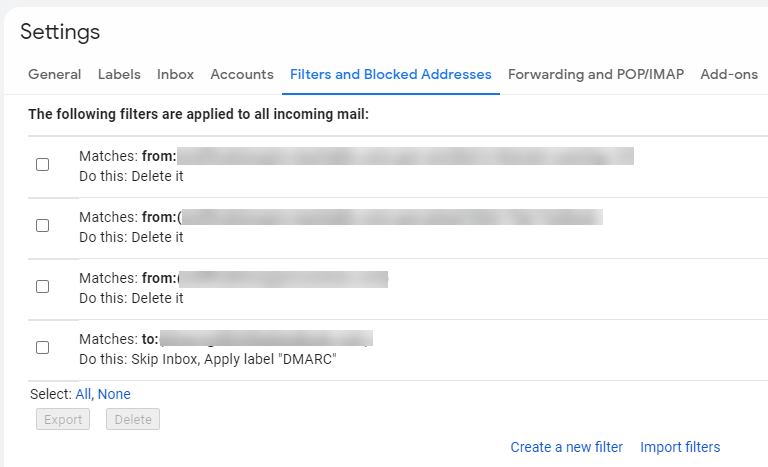

7. Don't reply all unless you need to
I’d love to say that this one isn’t necessary anymore in an email productivity post like this. But, sadly, it still is necessary.
Here’s a public service announcement from everyone you send email to.
Reply = sending a message back to the person who sent you the email.
Reply all = sending a message to everyone who received the email you just sent.
Folks. Many, many times, reply all just is NOT needed. Ask yourself this question before clicking “reply all”:
What will happen if everyone does not receive the message I’m about to send?
If the answer is not “catastrophe” or does not involve serious irrevocable damage to your school or other people, consider just clicking “reply” — or not sending a message at all.
Your email recipients will thank you.

8. Talk to your phone
Even if you're a fast typer, you still can type faster with your voice than with your fingers. We can leverage that to write emails faster and get on with our day.
This is voice typing (or dictation, depending on what your device calls it).
Call me weird, but I struggled to get used to it at first. I wouldn't use it unless I was totally by myself. Nowadays, I'll voice type by just mumbling quietly to my phone -- even in a crowded room.
It saves me a TON of time. Most people can type 38 to 40 words per minute with a keyboard. However, when you speak, that speed surges to 150 words per minute.
In the Gmail app on your phone, click the little dictation microphone on the keyboard to type with your voice.
Consider responding to emails with your phone using the voice typing feature. Or use some of the Chrome extensions available. Or set up your computer using its built-in dictation settings.

9. Set boundaries
Think of your email like that obsessive, needy "significant other" you once had in your life.
Tell your email, “Listen, we need to talk. It’s not you. It’s me. (OK, really, it IS you.) We need to establish some boundaries because you’re consuming too much of my time. I promise this is in the best interest of both of us.”
- Hide your email icon on your phone in a folder.
- Turn off the notifications and check it intentionally.
- Delete email off your phone completely. (Lots of people do this and just manage email on their computers — so it doesn’t become a digital leash!)
There’s no app for this. It takes a conscious decision by you and the willpower to follow through on it. But if email is consuming too much of your life and you’d like to reclaim those hours, it’s probably a no-brainer decision!

10. Use Keep notes instead of sticky notes
OK, I'll be honest. I still love paper sticky notes. I'll probably never stop using them. But with Google Keep sticky notes sitting right there on the side of my Gmail screen, they offer lots of benefits:
- They go with you wherever your Google account goes
- You can add more notes with the Google Keep app on your phone
- You can put images on your Keep notes
- Keep will read the text in your images so you can search for it
If you've ever put a sticky note on your desk at work and needed it at home, you understand the joy of having your notes with you all the time!
You'll find Keep notes in the rail along the right side of Gmail on a browser. Click on it to open up a sidebar with your notes.
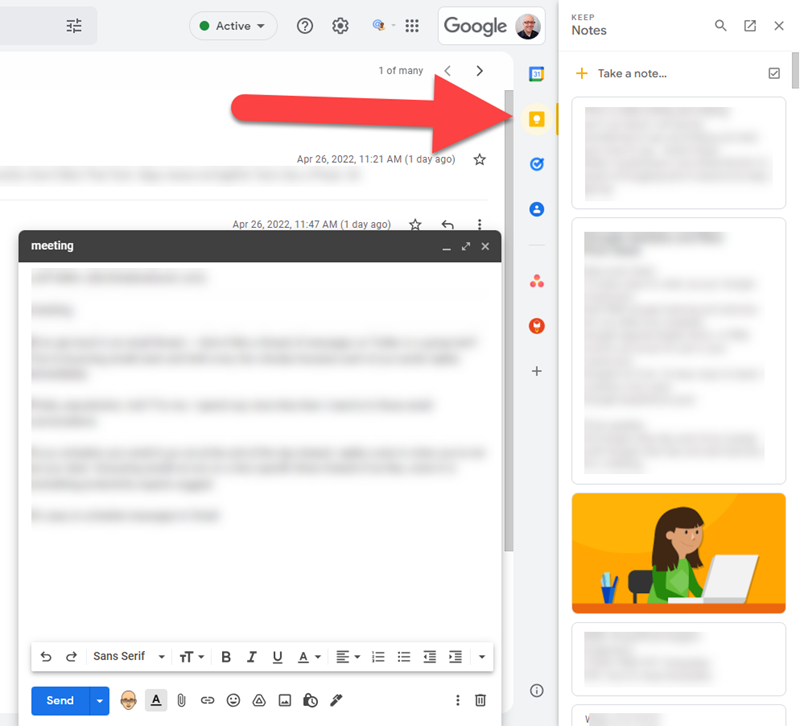

11. Keep track of tasks with Tasks
This is another one that's hiding in plain sight, on the right side rail of your Gmail browser window. This may be your jam if you're a big to-do list person -- if checking tasks off your list makes you extraordinarily happy.
Pop open the Google Tasks sidebar with the blue circled check icon. You can add individual tasks to any number of task lists. You can even organize by subtask and indent them. When they're done, check them off.
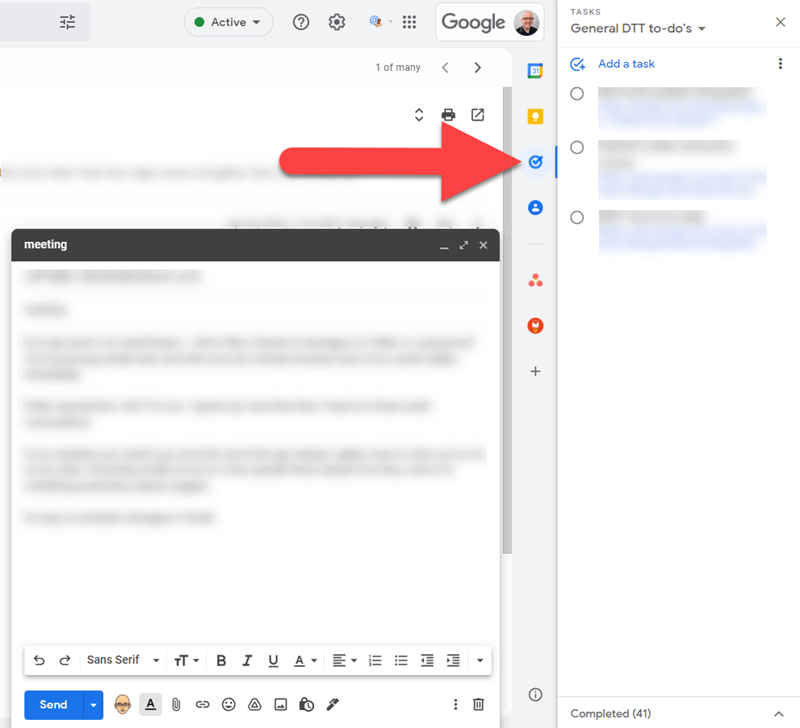

12. Create and save common emails with templates
If you've ever felt like you're writing the same emails over and over and over again, this one's for you.
Maybe you say the same thing in emails to parents. Maybe you replicate your response to certain student emails.
It's time consuming. But it doesn't have to be.
Next time you write one of those "I write this all the time" emails, go to the three dots menu in the message (browser version, not app version) before you send it. Choose "Templates" and choose "Save draft as template."
If you want to apply a template, just create a new message and go to the same place but choose the name of the template instead. It'll insert that message, which you can edit and send.
This is helpful even if you have to make certain adjustments to emails before you send them. You can add a placeholder (i.e. "Add student comment here") where you can type custom text before sending.

13. Organize your inbox with stars
Imagine if you could put little tags on the messages in your inbox, color coding them so you could see what you need to do with them next.
It's sitting right there waiting for you!
You may put a star on an email message before. But one little yellow star isn't where that stops.
In the settings, you can create all sorts of colorful variations of the yellow star to categorize your messages. Just go to Settings and scroll down to "Stars" in the general menu. Drag all the stars -- or variations like exclamation points, question marks, or check marks -- to the "in use" line.
To add a star to a message, click the star ... and just keep clicking to cycle through all the options you just set above.

14. Set up a system of labels
For some of us, we're still calling these "folders." But in Gmail, they're labels. They're a way of sorting messages so we can get to all of them we've organized together. The benefit of labels over folders: you can add multiple labels to a message, whereas the old folder system let you only store it in one place.
For me, labels are LIFE. I label lots of important messages so I can group them and find them later. They're in the left sidebar of the browser version of Gmail. Use the + button to add a new label. You can drag messages into the labels -- or drag labels on a message.
There are two keys to a good label system: knowing WHAT to label and knowing how to ORGANIZE it.
- What to label: Think about the kinds of messages you actually go back to after they're read and archived. You don't want to label every single message you get. Why organize messages you'll never look at again? Prioritize the ones you know you'll want to see again.
- How to organize it: You can add main labels and sublabels. Consider using main labels as big categories (i.e. a specific class, a content area, a grade level, a month) and adding sublabels to organize those big labels.
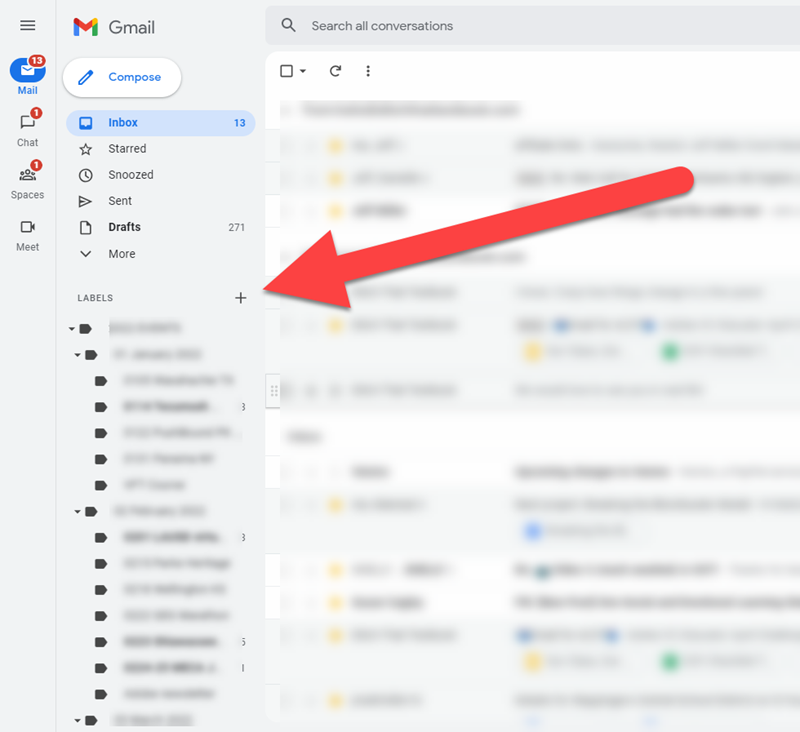

15. Level up your email searching game
I just told you that labels are my life. But, truth be told, I don't look up messages in my labels as much as another way.
I search. A LOT.
I search my email for the name of a sender. I search for a key word in a message. Sometimes, I'll search for messages over a specific time period.
To do that, you need to level up your email searching game. And easy way to do it is to use the settings button in the search bar for an advanced search. It'll let you specify messages using lots of criteria.
When you get even more adept, you'll be able to type some of these right into the search bar. They're called "search operators," and when you learn a few of them, it'll make finding messages so much faster. (I often use the from:, to:, and subject: operators.)
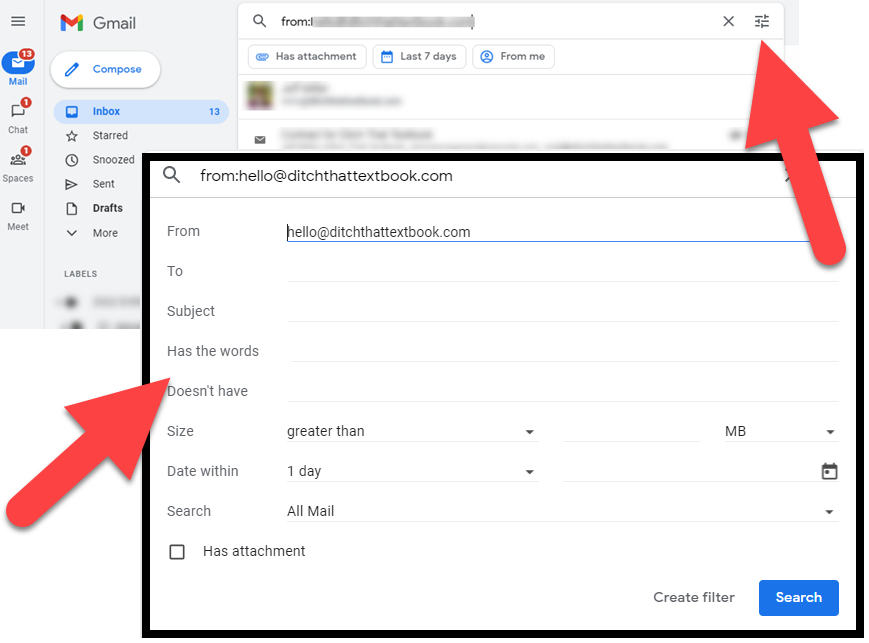

16. Snooze emails into the future
Sometimes, I like to keep messages in my inbox that I need to take action on. But I don't like them cluttering up my inbox.
One way to avoid this: snooze them to the future. Use the little icon that looks like a clock (or the "Snooze" option in the three dots menu inside a message in the mobile app). Then choose a time in the future for the message to reappear.
You can always find those snoozed messages in the "Snoozed" folder in Gmail.
Pro tip: Don't use this to delay the inevitable! Snoozing a message because you don't want to act on it doesn't make you more productive. But if you need a message for a meeting you'll have on Tuesday at 4pm, snoozing it until Tuesday at 3pm will make it pop up exactly when you need it.
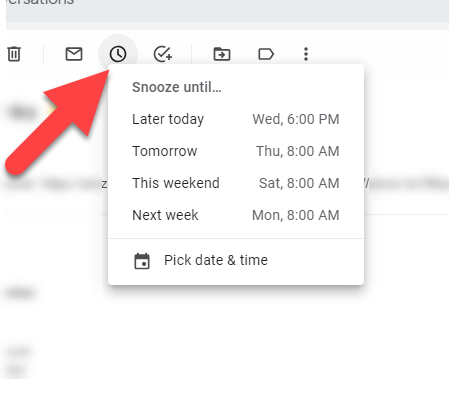

17. Use nudges so you respond every time
Sometimes I'll forget that something is in my inbox and I won't respond. (I'm not the only one, right?)
It's nice to have a reminder so I don't make that mistake over and over again.
If you haven't turned on nudge notifications, you might consider it. Nudges are little reminders from Gmail to take action you might have overlooked. Gmail will bring a message back to the top of your inbox and put a little orange "nudge" notification on it so you don't forget.
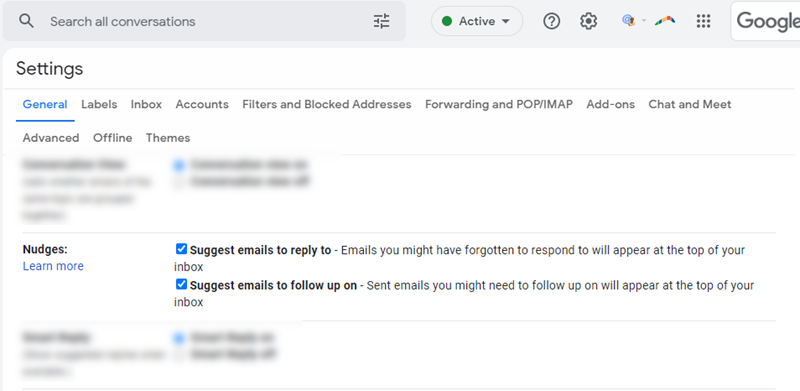

18. See everything with multiple inboxes
This is a new one for me! Multiple inboxes let you create special inboxes for important messages you don't want to miss:
- Create an inbox with only your starred messages.
- Create an inbox that displays messages received from important people.
- Create an inbox that displays messages with a specific label.
You can use any search operator (we learned about those above!) to create a special inbox. You can even specify how many messages it displays and where to put them. For example, I've added two new inboxes on top of my main inbox for messages received by two others from Ditch That Textbook.
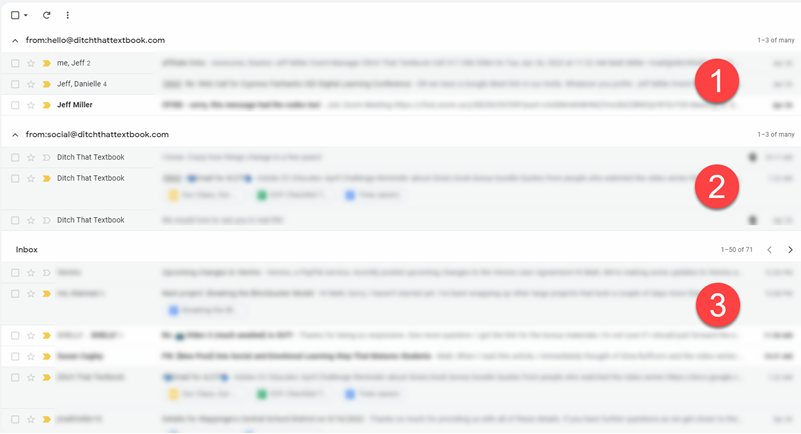

19. Insert a signature with important details
Adding a signature at the bottom of your message helps people know who you are and how to get in touch with you.
But it can do more. You can use your signature ...
- to list office hours and other important details
- to inspire with a quote
- to share a book you're reading
If your recipient might find it helpful, you might add it to your signature.
I've also use a third-party signature app, WiseStamp (wisestamp.com), to add extra details (better design, buttons to social media, etc.).


20. Add contacts to compose messages faster
Sometimes, I'll start to write a new message and I'll add whom I'm sending it to. I expect it to auto-complete the person's email address, but Gmail can't seem to find it.
That's because it auto-completes people saved to your contacts. Two tips can help this process go faster:
- Tell Gmail to create contacts automatically when you send a message to a new person. You'll find that setting under General.
- Add contacts manually that Gmail misses. Just click on a message from that person and hover over the profile picture. Click the add contact icon -- or the pencil icon to edit that person's contact.
When someone is added as a contact, Gmail will auto-complete their email address in the future.
What are your best email strategies? Which of these are you most likely to try? Tell us in a comment below!


Thank you for your tip on creating multiple inboxes. I had no idea I could do that and it will be a time saver!
I am a self-taught G Suite user and recently synched all my email accounts. This article has helped me tremendously! I had no clue there were so many features, but most importantly the breakdown and visuals made it super easy for me to follow! I will share it with my district!
Many features I have used, but others I did not even existed. Interesting and good tips
Very good article about Gmail. I will use these tips.